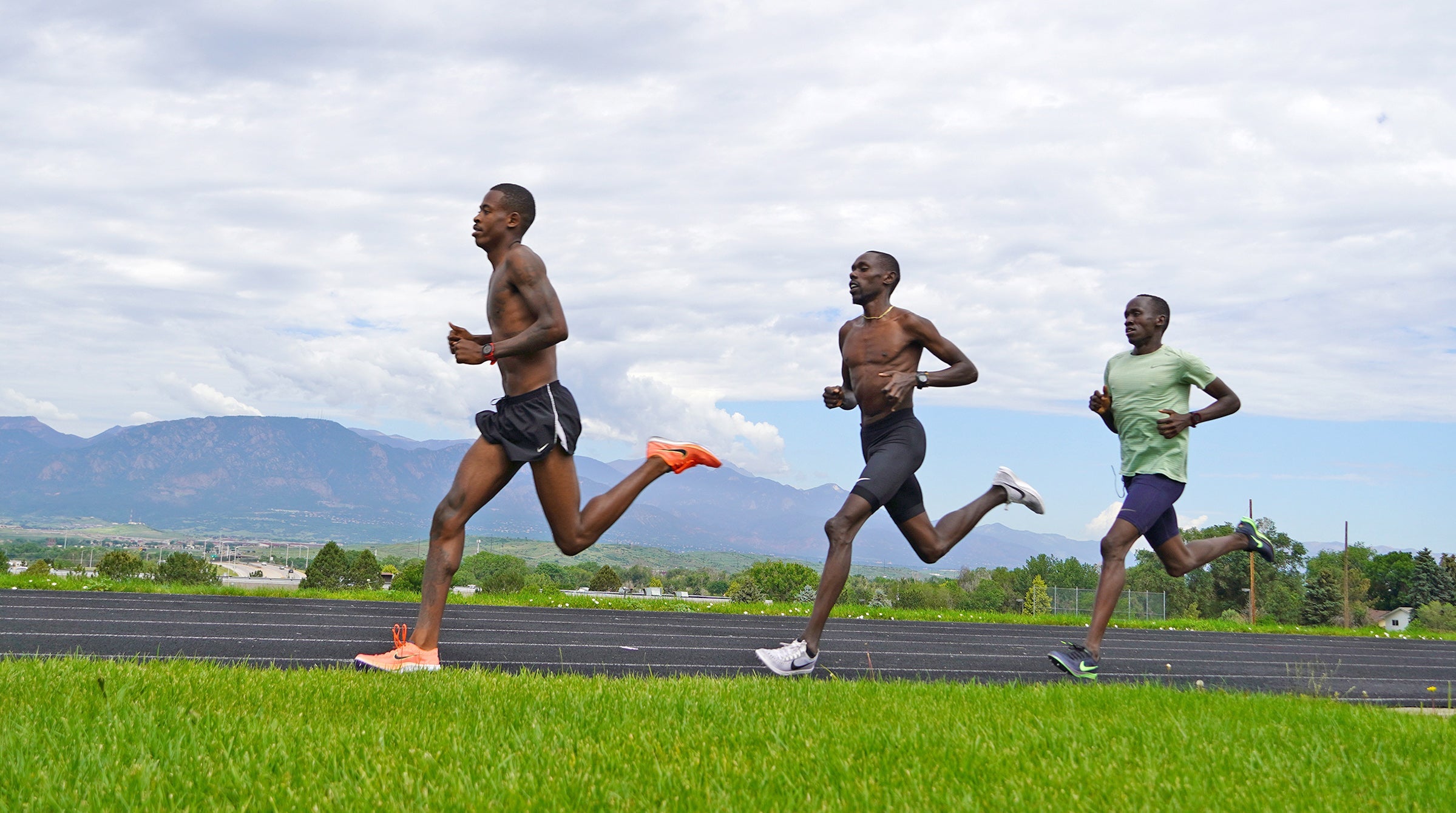It’s just after 9 a.m. on a recent Tuesday morning at Mesa Ridge High School in Fountain, Colorado, as a maintenance team finishes mowing the grass on the infield of the all-weather track. It’s already getting hot as an assortment of recreational runners and walkers conclude a few easy laps and a gaggle of teenage boys gathers and heads out for a training run to prepare for the fall cross country season.
The track is momentarily clear and, in the moments that follow, the main act begins to arrive. One after another, lanky Kenyan-Americans begin to pull up in cars that range from well-worn Honda Civics to shiny new Cadillacs.
Among them is Paul Chelimo, fresh off a win in the 5,000m at the U.S. Olympic Trials in Eugene, Oregon. Then comes Lenny Korir, a U.S. Olympian in 2016 at 10,000m and 4th in the marathon team trials last year — and Emmanuel Bor, 5th in the 5,000m at the 2021 U.S. Trials with 27-minute 10K speed. Chelimo is, of course, preparing for Tokyo, while Korir and Bor are both honing their track fitness for mid-summer races. Their coach, Scott Simmons, pulls up and joins them.
After a warm-up, some light stretching, drills, and plenty of good-natured banter and laughter, they lace up their spikes and get serious. They methodically burn up the track with four sets of a 1,000-meter/600-meter combo with 2 minutes rest in between each interval. With a rolling start, they run single-file on the inside lane and make 4-minute mile pace at nearly 6,000 feet above sea level look impressively smooth and relatively easy — even though it’s clearly not. The trio hits each of the 1,000s at 2:30-2:32, while they click off the 600s at 1:28-1:32.
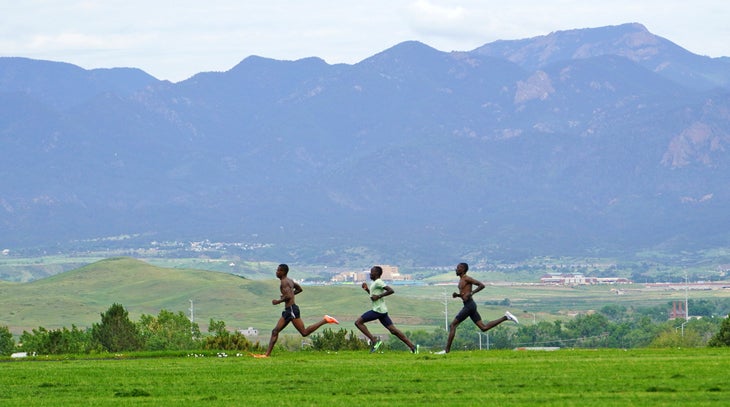
“I definitely feel fit,” Chelimo says with a smile after he finished a cool-down jog. “The big thing is to get the resistance. The speed is there. The goal of the workout today was to get that resistance so when I’m in a race, and we pick up to 2:30 per kilometer, it will feel OK. A few years ago, when I was in a race, and we started going 2:32-2:33 per K, I was like, ‘This is crazy!’ But now 2:32-2:33-2:34 is okay, because that’s what we do in workouts and it seems normal.”
Gratitude Breeds Success
Although Simmons and the program maintain a relatively low profile compared to other training groups around the U.S., the success of the athletes in his American Distance Project (ADP) — which includes athletes from the U.S. Army’s World Class Athlete Program (WCAP) — speaks volumes.
The 53-year-old coach has helped guide seven U.S. distance runners to the U.S. Olympic team since 2016, including this year’s Olympians: Chelimo in the 5,000m, and Hillary Bor (Emmanuel’s younger brother) and Benard Keter in the 3,000m steeplechase. He’s also helped several more make it to the world championships and many to fast half marathons and marathons.
Most — but not all — of the current runners in the ADP/WCAP group are Kenyan Americans who ran collegiately in the U.S. and earned citizenship through the U.S. Army or a traditional green card application process. While there is an obvious cultural connection that’s inherent to the group — with occasional kidding and phrases spoken in Swahili — it’s the shared appreciation of their opportunity and the mutual commitment to hard work that has made this team very successful. Nike supports the WCAP track and field program, which is based out of the Army’s nearby Fort Carson, along with Chelimo, Shadrack Kipchirchir, another 2016 Olympian at 10,000m, and Simmons on an individual basis, while Hillary Bor is a Hoka-sponsored athlete.
The ADP’s origin dates back to 2008 while Simmons was coaching at NCAA Division II Queens University of Charlotte in North Carolina, but the group’s most notable success has occurred since he moved to Colorado Springs in 2012 and after took over as head coach of the WCAP in 2016.
Between North Carolina and his early days in Colorado, Simmons coached a variety of up-and-coming American athletes, including Justin Young, a 2:13 marathoner, Fernando Cabada, a 2:12 marathoner and former U.S. 25K, record-holder, junior standout Katie Rainsberger (when she was in high school), national-class marathoners Wendy Thomas, Brianne Nelson and Alisha Williams, and sub-4-minute milers Craig Miller and Matt Elliott.
In the past five years, he’s helped ADP athletes earn more than a dozen top-10 finishes in global track meets and major marathons.
“The group has continued to evolve, and so has my coaching,” says Simmons, whose style has been influenced by a variety of coaches, including Joe Vigil and Renato Canova. “The goal back then was to qualify for the Olympic Trials and World Championships. Now the goal is to make the team and to earn medals.”
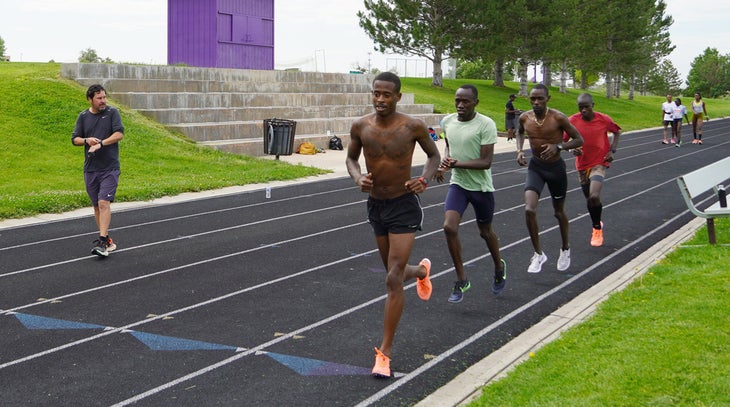
Harambee: All Pull Together
In addition to Chelimo, Keter, Korir, Kipchirchir, and the Bor brothers, the group today includes marathoner Augustus Maiyo, 5th at the 2020 U.S. Olympic Trials Marathon in Atlanta behind Korir, and road and track runners Elvin Kibet and Ednah Kurgat, a former NCAA cross country champion. Others who occasionally train with the group include Sam Atkins, a 2021 British Olympian in the 10,000m, Joe Gray, a two-time world champion trail runner and 18-time U.S. champion, and Mikey Brannigan, the 2016 Paralympic 1,500m champion with autism who famously broke 4 minutes for the mile at age 19.
To Simmons, it’s the epitome of the Kenyan tradition of Harambee — which means “all pull together” in Swahili.
“It’s a great training group; it’s like a village,” Simmons says. “We have people come out and join us for workouts. I don’t think Bowerman Track Club would allow that, but for us it just adds positive energy. If you’re willing to do the work, then you’re welcome here.”
On any given workout day in Colorado Springs, there’s loads of new talent joining the Olympians for group workouts, including Ethiopian runners Nuhamin Bogale and Atsede Baysa, who will be running the Boston Marathon in October.
“The program pretty much recruits itself,” Simmons says. “I think runners hear about the way we work and the results we’ve achieved. Plus, I think Colorado Springs happens to be, in my opinion, the best place to train in the U.S. and maybe the world, especially with the easy access to a variety of elevations we have, between 5,000 and 10,000 feet above sea level.”
Simmons knows Bor and Keter have the talent and skill to make the steeplechase finals in Tokyo, and, once there, anything can happen. As for Chelimo, he’s definitely medal contender, although he’s only raced three times outdoors so far this year — a 3,000m race (7:41.69) in the Czech Republic on May 19 and the prelims (13:36.66) and finals (13:26.82) at the U.S. Olympic Trials in Eugene in late-June. (He also ran an impressive 13:09.90 indoor 5,000m at a WCAP time trial meet in Virginia back in March.)
“I was really crushing workouts this spring and I’m still building on that,” Chelimo says. “I came to realize the less racing I do, the better I perform in races because I believe I am mentally really tough. And once I get to Tokyo, it’s all about getting to the final and then it’s like I say, ‘Go hard or suffer for the rest of your life.’”
Key Workouts
American Distance Project coach Scott Simmons puts his runners through high-volume training (110–120 miles per week) during the first part of the year, but then drops the mileage (80–90 miles per week) as the competitive season draws near and the focus changes to more on quality work on the track.
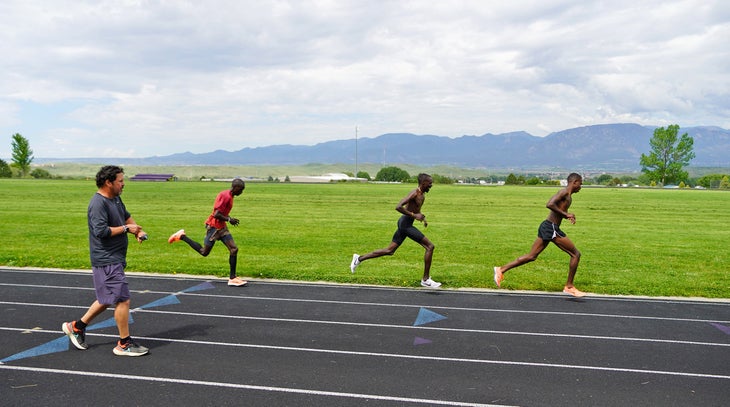
Two key workouts the group regularly does during the track and marathon season are speed development sessions on recovery days and broken tempo runs on the track.
Speed Development Session
On a recovery day, run:
- 6 miles easy
- 2 x 200
- 2 x 150
- 2 x 100
- Each set progressively faster, with full recoveries
When Hillary Bor joined the group in 2016, he had a lot of steeplechase experience from his days running at Iowa State, so his technique was pretty good. But he wasn’t that fast, entering the U.S. Olympic Trials with a modest 8:32 PR after hovering between the low-8:30s and mid-8:40s for the previous eight years.
What complicated the matter initially was that Bor wasn’t yet in the WCAP so he was working a full-time job to make ends meet. Simmons knew Bor had the ability to run faster, but aside from building his fitness he knew he had to help him build his speed — and specifically his closing speed — if he wanted to be able to compete for an Olympic berth and also compete on an international level.
One of the components Simmons added in balance with specific track workouts, hurdle workouts, tempo runs and long runs, was a speed development session on Saturdays, which had normally been a recovery day that called for a 10-mile easy run. Instead, Simmons started having Bor and fellow steeplechaser Stanley Kebenei run a 6-mile easy run that finished at the track, where they’d change into spikes and then do 2 x 200m, 2 x 150m and 2 x 100m. Each rep includes full rest and each is run progressively faster.
Simmons extended that recovery-day speed development workout to all of its runners, including the marathoners. (The steeplers often do the longer sprint intervals over low hurdles.)
“It definitely helped Hillary in 2016 as he closed hard to finish second in a surprise and make the Olympic team that year,” Simmons says. “But I think it’s helped everybody with their closing speed. It’s meant to be a fast, fun workout that’s all about working on mechanics and neuromuscular timing.”
Broken Tempo
Replace a traditional 6-mile tempo run done at 15K pace with:
- 3 miles @ ~ 10K pace
- 3 minutes rest
- 2 miles @ ~ 10–15 seconds/mile faster
- 3 minutes rest
- 1 mile @ ~ 10–15 second/mile faste
- Optional: 3–4 x 400m or 200m @ mile race pace
When the WCAP group first started training together in 2016, Simmons would send them out on a weekly 6-mile tempo run on the roads or a flat, soft-surface trail. The 6-mile efforts would build progressively, starting around 5:15 pace and finishing at 4:30 pace.
But in recent years, Simmons has broken those sessions up into a workout on the track that typically includes 3 miles hard (roughly 13:45-14:05 or roughly 4:35-4:42 pace), followed by 3 minutes rest, then 2 miles hard (8:50-9:10 or 4:25-4:35 pace), followed by 3 minutes rest, and then 1 mile hard (usually 4:10 or faster). Sometimes a series of fast 400s (52-54 seconds) or 200s (25-27 seconds) replace the mile or are tacked on at the end — depending on what the coaches and athletes feel like they need or how close they are to their next race.
“We break it up so we can get a higher quality of threshold work,” Simmons said. “And doing it on the track really toughens the mind, too. We have a mile loop that’s a soft surface trail and that’s really great when we’re training for marathons or road races, but if you want to be able to teach yourself to focus on the track, 25 laps or 12 ½ laps, it’s good to be able to do that work on the track.”
American Distance Project 2021 Olympians
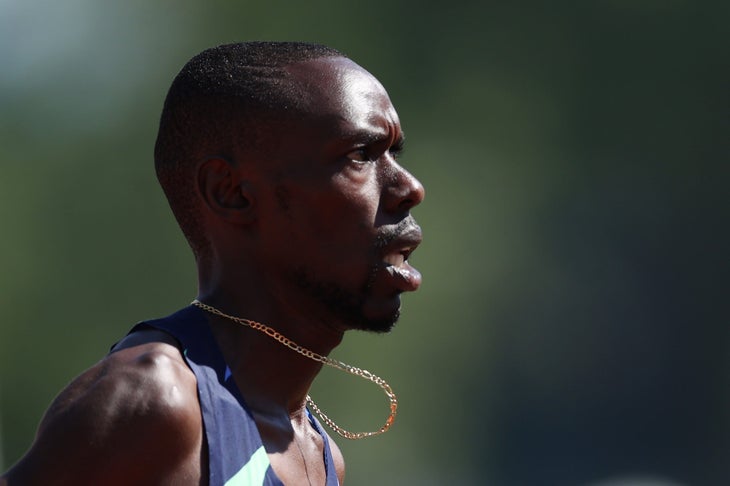
Paul Chelimo, 5,000m
Age: 30
Birthplace: Iten, Kenya
Residence: Colorado Springs, Colorado
Paul Chelimo arrived in the U.S. in 2010 to attend Shorter College in Arkansas and earned three NAIA national titles before transferring to University of North Carolina at Greensboro, where he posted back-to-back NCAA titles in the 5,000m in 2012 and 2013. He became a U.S. citizen via the Army through the Military Ascensions Vital to National Interest (MAVNI) program as a water treatment specialist. (He says he hopes to use that experience to develop new water treatment plants in Kenya when he retires from competitive running.)
While a WCAP member, he was the silver medalist in the 5,000m at the 2016 Olympics and the bronze medalist at the 2017 World Championships. Once he completed his four-year term in the Army, he signed with Nike in 2018 and posted a 12:57.55 PR.
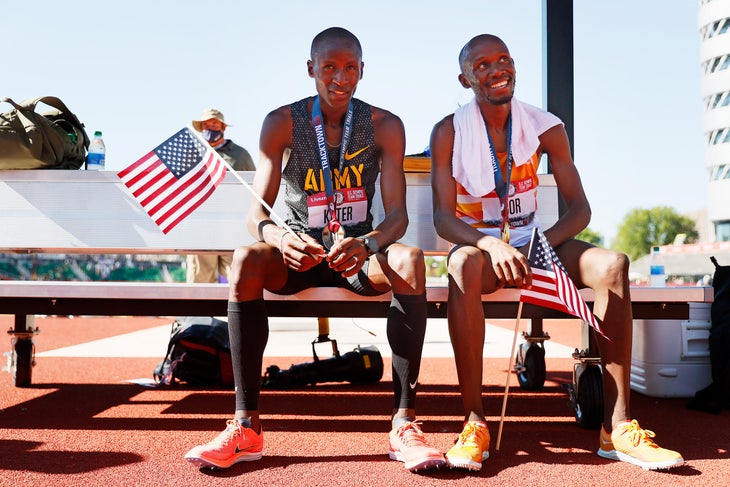
Hillary Bor, 3,000m steeplechase
Age: 30
Birthplace: Eldoret, Kenya
Residence: Colorado Springs, Colorado
Following in the footsteps of his older brothers, Hillary Bor attended Alabama for a year before transferring to Iowa State, where he racked up three top-four NCAA finishes in the 3,000m steeplechase. He joined the WCAP program and served in the Army as a financial management technician from 2013-2019 before signing with HOKA in 2020. He placed eighth at the 2016 Olympics and 9th at the 2019 World Championships in Doha, Qatar, where he lowered his steeplechase PR to 8:08.41. So far this season, he’s run two strong races at the U.S. Olympic Trials in June and a season-best 8:14.69 at the Diamond League meet in Monaco on July 9.
Benard Keter, 3,000m steeplechase
Age: 29
Birthplace: Molo, Kenya
Residence: Colorado Springs, Colorado
Benard Keter was a national junior college champion in the 3,000m steeplechase for Cloud Community College in 2014, the NAIA national champion in the event for Wayland Baptist in 2015, and a runner up at the 2016 NCAA Championships for Texas Tech. He joined the Army WCAP in 2017 and continues to serve as a unit supply specialist. He lowered his steeplechase PR at the U.S. Olympic Trials with an 8:21.81 runner-up finish behind Bor, then lowered it again to 8:18.53 on July 9 at the Diamond League meet in Monaco. Keter’s brother, Tareq Mubarak Taher, finished 11th in the steeplechase at the 2008 Olympics while running for Bahrain.


